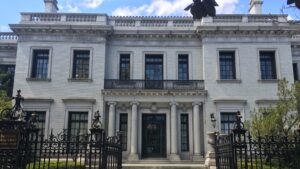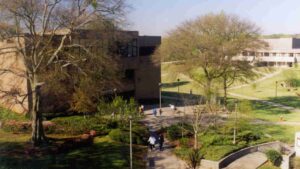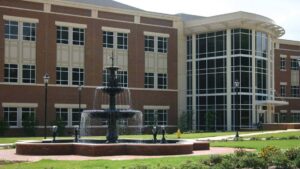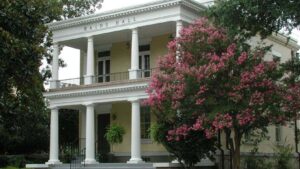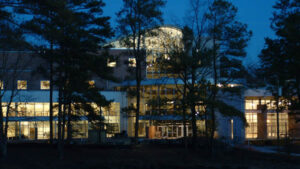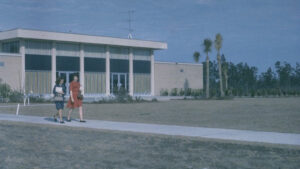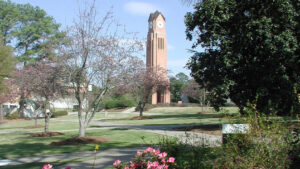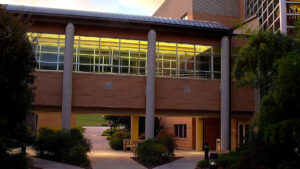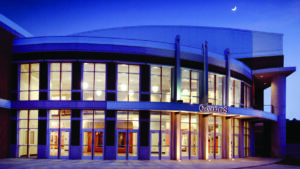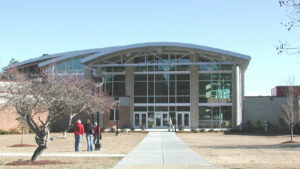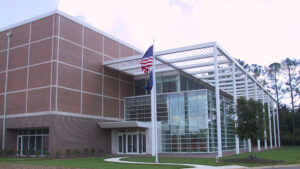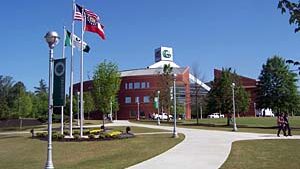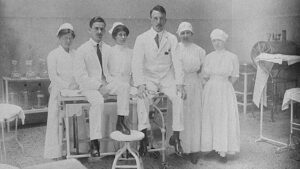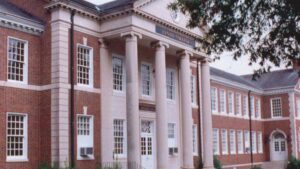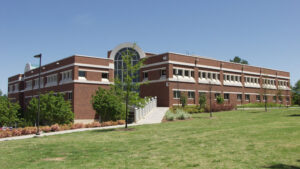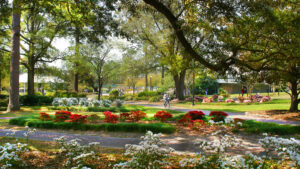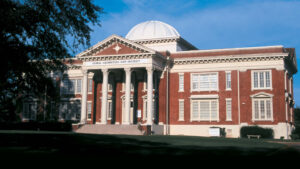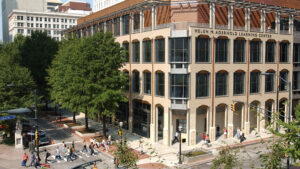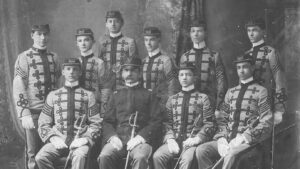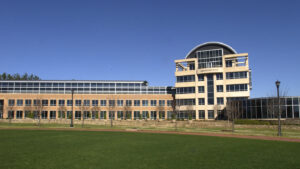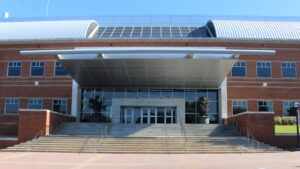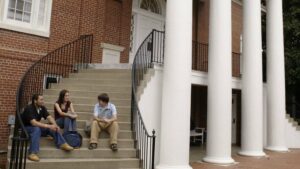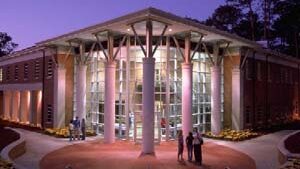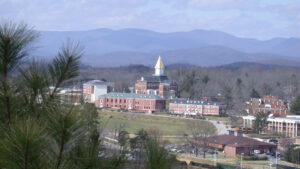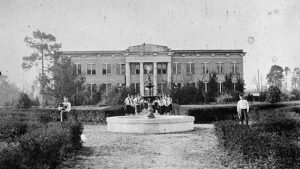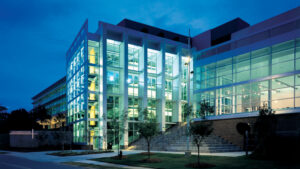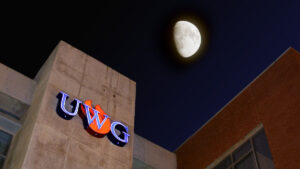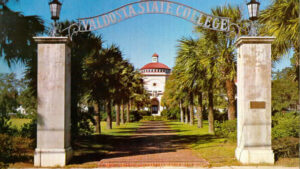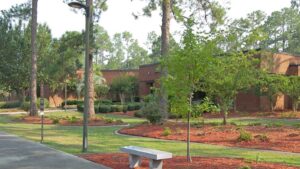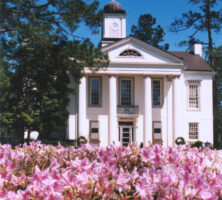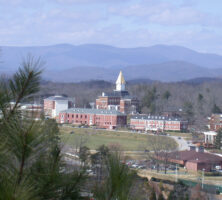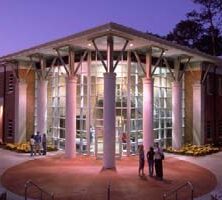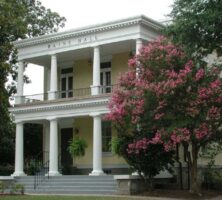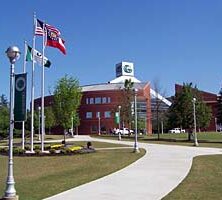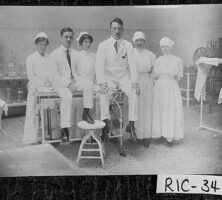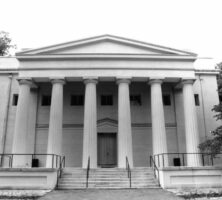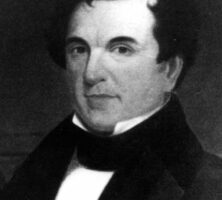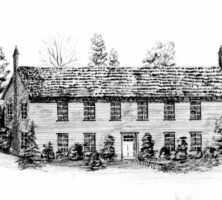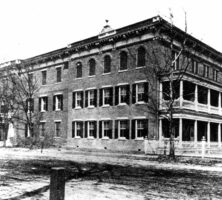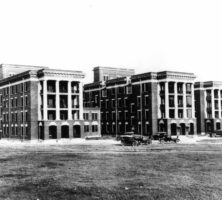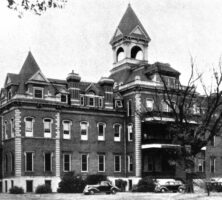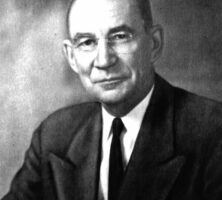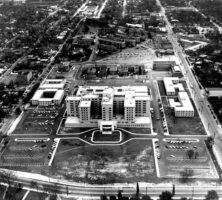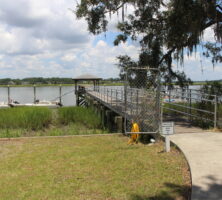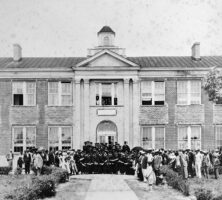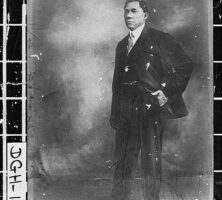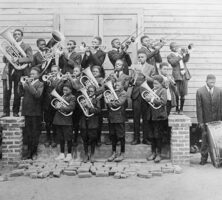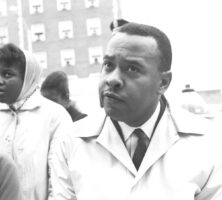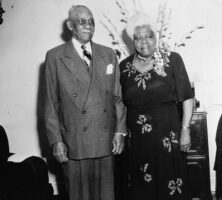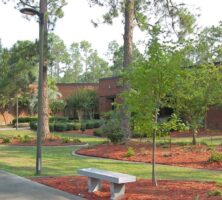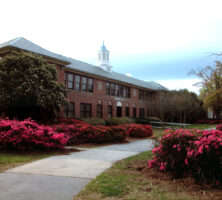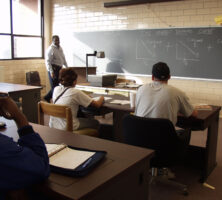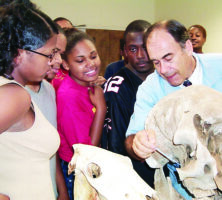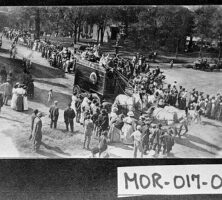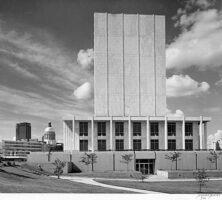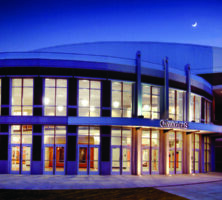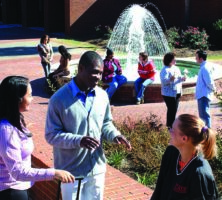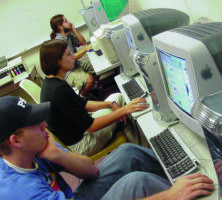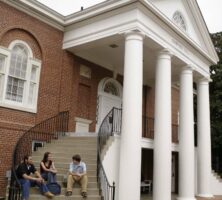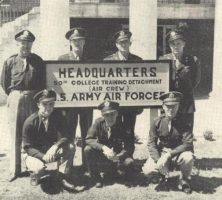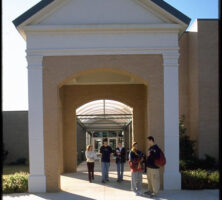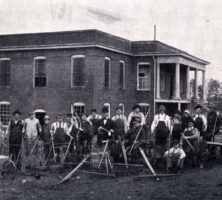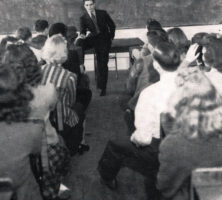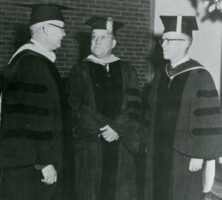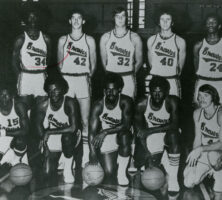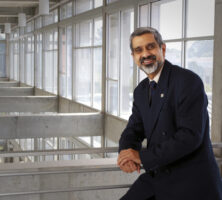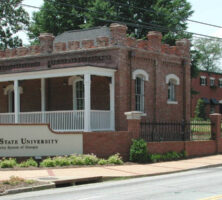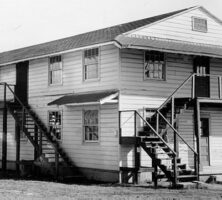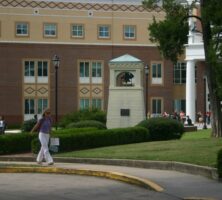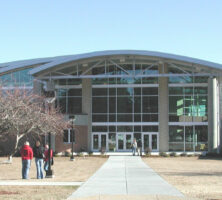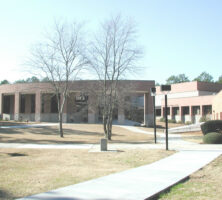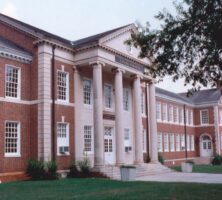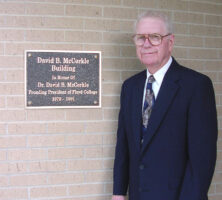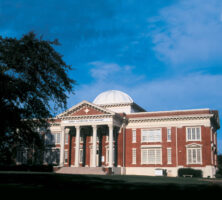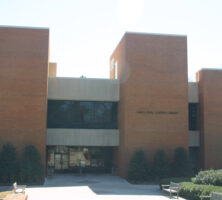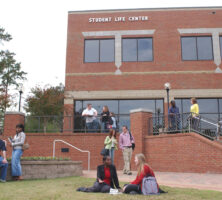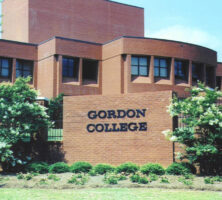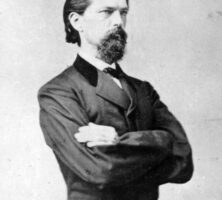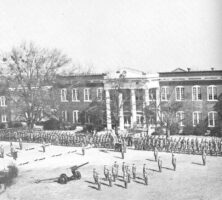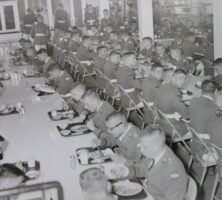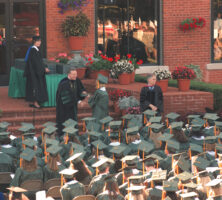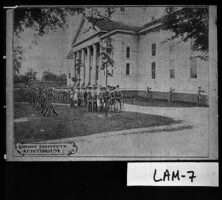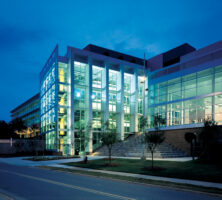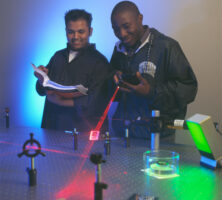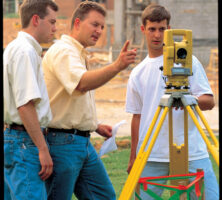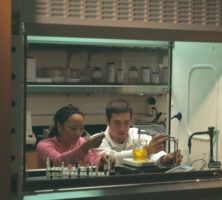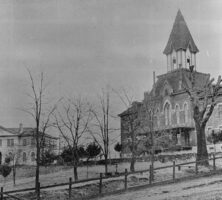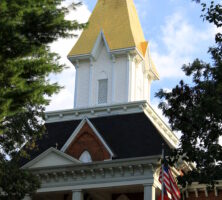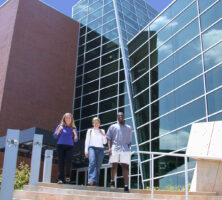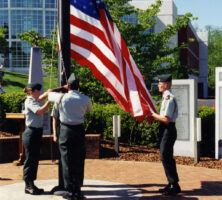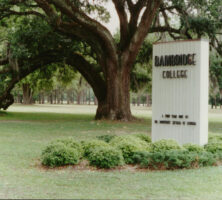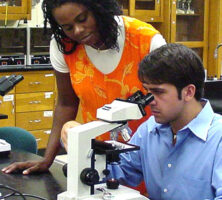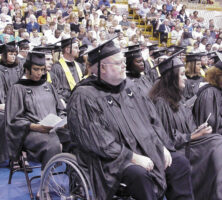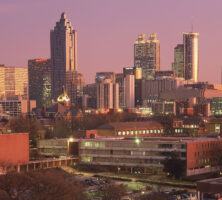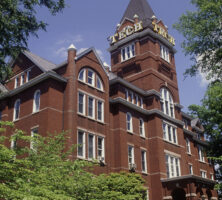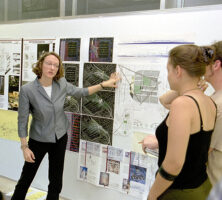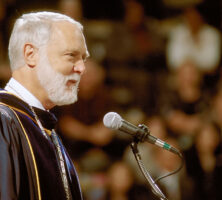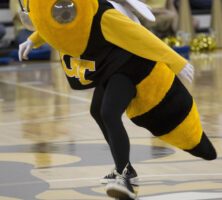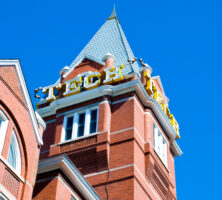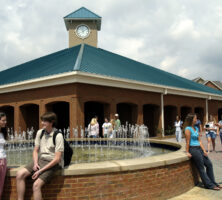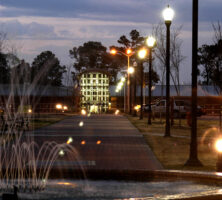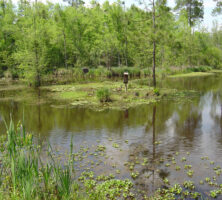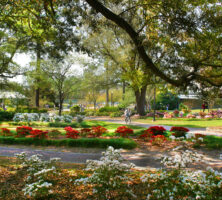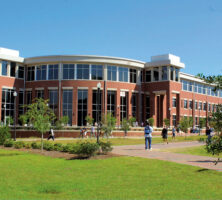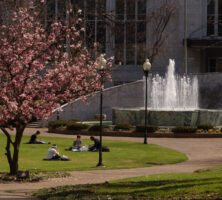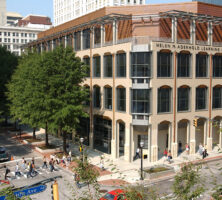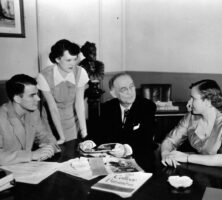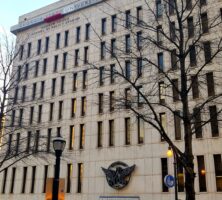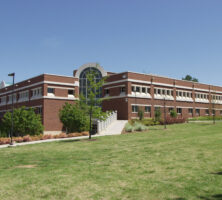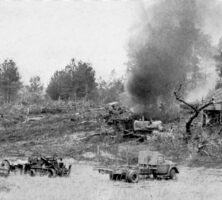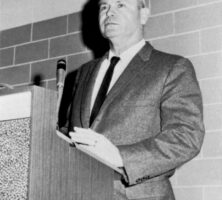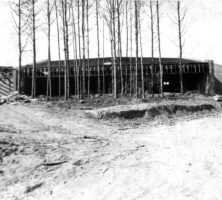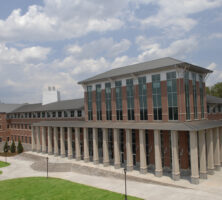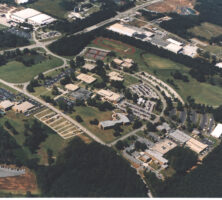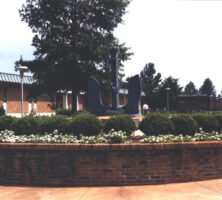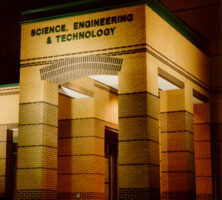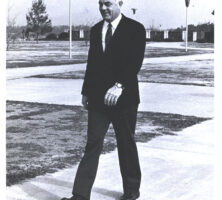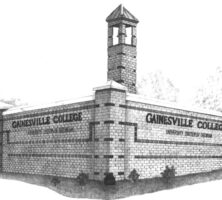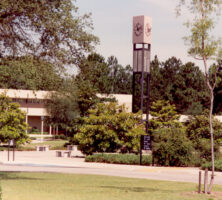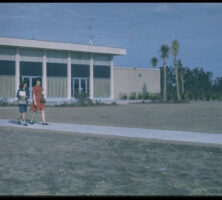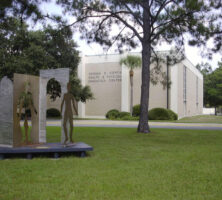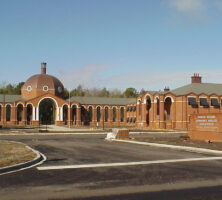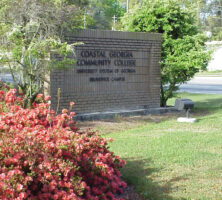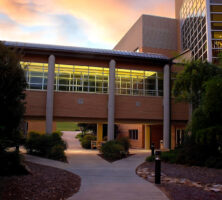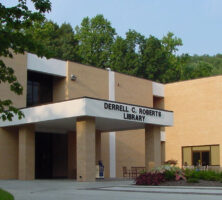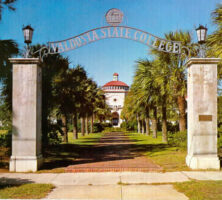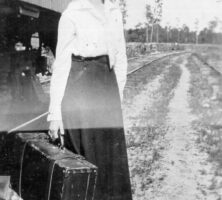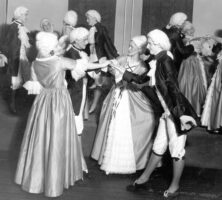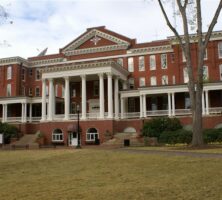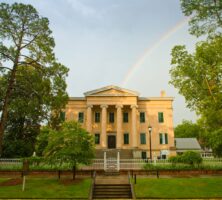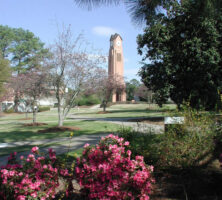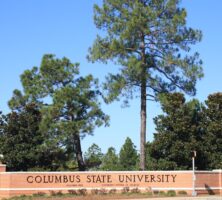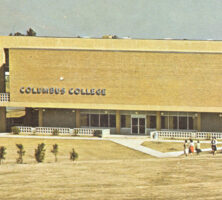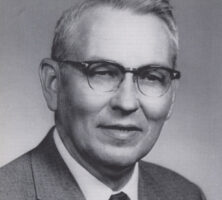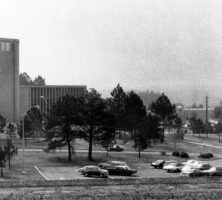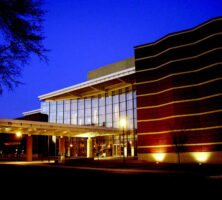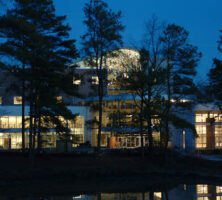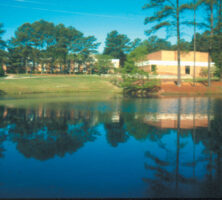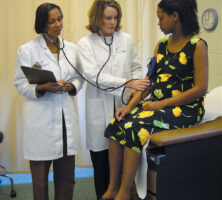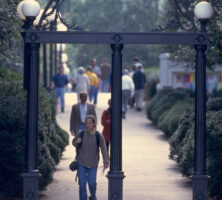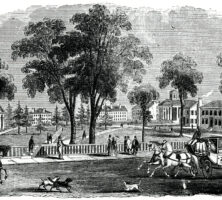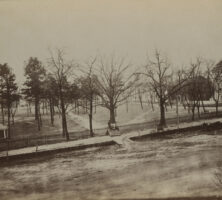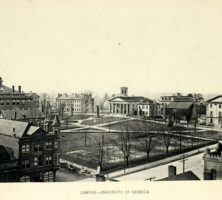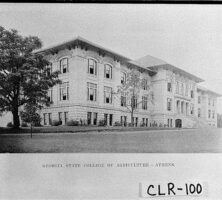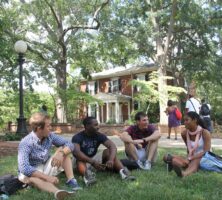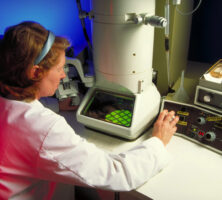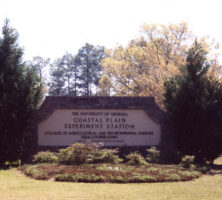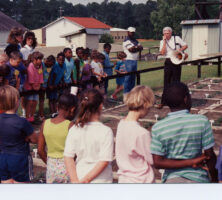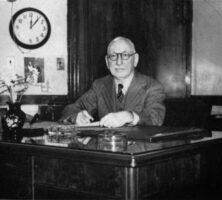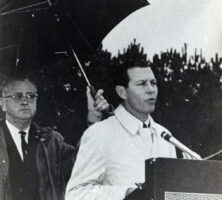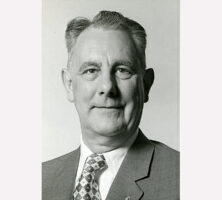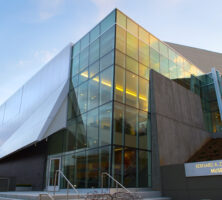The New Georgia Encyclopedia is supported by funding from A More Perfect Union, a special initiative of the National Endowment for the Humanities.
Thrash Hall, on the campus of South Georgia College in Coffee County, is named for the first president of the college and originally housed the school's library. Today the building, pictured circa 2002, serves as the president's office. Founded in 1907, South Georgia College is a four-year institution of the University System of Georgia.
Courtesy of South Georgia College
The New Georgia Encyclopedia does not hold the copyright for this media resource and can neither grant nor deny permission to republish or reproduce the image online or in print. All requests for permission to publish or reproduce the resource must be submitted to the rights holder.
The Blue Ridge Mountains surround the campus of North Georgia College and State University, one of six senior military colleges in the United States.
Courtesy of NGCSU Relations
The New Georgia Encyclopedia does not hold the copyright for this media resource and can neither grant nor deny permission to republish or reproduce the image online or in print. All requests for permission to publish or reproduce the resource must be submitted to the rights holder.
Courtesy of Tommy Thompson
The New Georgia Encyclopedia does not hold the copyright for this media resource and can neither grant nor deny permission to republish or reproduce the image online or in print. All requests for permission to publish or reproduce the resource must be submitted to the rights holder.
Rains Hall houses the offices of the university president, advancement, and public relations and publications at Augusta State University. The building is named in honor of Colonel George W. Rains, who reopened the Academy of Richmond County after its closure during the Civil War.
Courtesy of Augusta State University
The New Georgia Encyclopedia does not hold the copyright for this media resource and can neither grant nor deny permission to republish or reproduce the image online or in print. All requests for permission to publish or reproduce the resource must be submitted to the rights holder.
Building B, pictured in 2012, is the main administrative and classroom building at Georgia Gwinnett College in Lawrenceville. It was designed by prominent Atlanta architect John Portman.
Photograph by and reprinted by permission of Michael Gagnon
The New Georgia Encyclopedia does not hold the copyright for this media resource and can neither grant nor deny permission to republish or reproduce the image online or in print. All requests for permission to publish or reproduce the resource must be submitted to the rights holder.
The New Georgia Encyclopedia does not hold the copyright for this media resource and can neither grant nor deny permission to republish or reproduce the image online or in print. All requests for permission to publish or reproduce the resource must be submitted to the rights holder.
The New Georgia Encyclopedia does not hold the copyright for this media resource and can neither grant nor deny permission to republish or reproduce the image online or in print. All requests for permission to publish or reproduce the resource must be submitted to the rights holder.
The New Georgia Encyclopedia does not hold the copyright for this media resource and can neither grant nor deny permission to republish or reproduce the image online or in print. All requests for permission to publish or reproduce the resource must be submitted to the rights holder.
The New Georgia Encyclopedia does not hold the copyright for this media resource and can neither grant nor deny permission to republish or reproduce the image online or in print. All requests for permission to publish or reproduce the resource must be submitted to the rights holder.
Members of the operating room staff at the Medical Department of UGA (later Georgia Health Sciences University) in Augusta are pictured in the early 1900s.
Courtesy of Georgia Archives, Vanishing Georgia, #
ric034.
The New Georgia Encyclopedia does not hold the copyright for this media resource and can neither grant nor deny permission to republish or reproduce the image online or in print. Requests for permission to publish or reproduce the resource should be submitted to the Georgia Archives.
The original building on the campus of Georgia Health Sciences University, completed in Augusta in 1837, was designed by the architect Charles B. Cluskey. The structure, Cluskey's first major building, is an excellent example of the Greek revival style.
Courtesy of Georgia Health Sciences University
The New Georgia Encyclopedia does not hold the copyright for this media resource and can neither grant nor deny permission to republish or reproduce the image online or in print. All requests for permission to publish or reproduce the resource must be submitted to the rights holder.
The New Georgia Encyclopedia does not hold the copyright for this media resource and can neither grant nor deny permission to republish or reproduce the image online or in print. All requests for permission to publish or reproduce the resource must be submitted to the rights holder.
Milton M. Antony, a physician in Augusta, was instrumental in the 1828 founding of the Medical Academy of Georgia, which later became Georgia Health Sciences University.
Courtesy of Historical Collections and Archives, Robert B. Greenblatt, M.D. Library, Georgia Health Sciences University
The New Georgia Encyclopedia does not hold the copyright for this media resource and can neither grant nor deny permission to republish or reproduce the image online or in print. All requests for permission to publish or reproduce the resource must be submitted to the rights holder.
The city hospital in Augusta, built in 1818, served as the first home for Georgia Health Sciences University, from 1828 until the mid-1830s.
Courtesy of Historical Collections and Archives, Robert B. Greenblatt, M.D. Library, Georgia Health Sciences University
The New Georgia Encyclopedia does not hold the copyright for this media resource and can neither grant nor deny permission to republish or reproduce the image online or in print. All requests for permission to publish or reproduce the resource must be submitted to the rights holder.
The New Georgia Encyclopedia does not hold the copyright for this media resource and can neither grant nor deny permission to republish or reproduce the image online or in print. All requests for permission to publish or reproduce the resource must be submitted to the rights holder.
A new city hospital in Augusta, which opened in 1869 and served for many years as the clinical training site for students at the Medical Department of UGA (later Georgia Health Sciences University), is pictured in 1894, following a renovation.
Courtesy of Historical Collections and Archives, Robert B. Greenblatt, M.D. Library, Georgia Health Sciences University
The New Georgia Encyclopedia does not hold the copyright for this media resource and can neither grant nor deny permission to republish or reproduce the image online or in print. All requests for permission to publish or reproduce the resource must be submitted to the rights holder.
University Hospital, completed in Augusta in 1915, was built for the Medical Department of UGA (later Georgia Health Sciences University) with the city's backing.
Courtesy of Historical Collections and Archives, Robert B. Greenblatt, M.D. Library, Georgia Health Sciences University
The New Georgia Encyclopedia does not hold the copyright for this media resource and can neither grant nor deny permission to republish or reproduce the image online or in print. All requests for permission to publish or reproduce the resource must be submitted to the rights holder.
The Newton Building, on the campus of the Medical College of Georgia (later Georgia Health Sciences University) in Augusta, was occupied by the college from 1913 until 1956. The structure was demolished in 1960.
Courtesy of Historical Collections and Archives, Robert B. Greenblatt, M.D. Library, Georgia Health Sciences University
The New Georgia Encyclopedia does not hold the copyright for this media resource and can neither grant nor deny permission to republish or reproduce the image online or in print. All requests for permission to publish or reproduce the resource must be submitted to the rights holder.
University Hospital, part of Georgia Health Sciences University in Augusta, was expanded in the mid-1930s as part of an effort to restore the good rating of the college and its membership in the Association of American Medical Colleges.
Courtesy of Historical Collections and Archives, Robert B. Greenblatt, M.D. Library, Georgia Health Sciences University
The New Georgia Encyclopedia does not hold the copyright for this media resource and can neither grant nor deny permission to republish or reproduce the image online or in print. All requests for permission to publish or reproduce the resource must be submitted to the rights holder.
G. Lombard Kelly served as dean of the Medical College of Georgia (later Georgia Health Sciences University) from 1934 until 1950, and as the college's first president from 1950 to 1953.
Courtesy of Historical Collections and Archives, Robert B. Greenblatt, M.D. Library, Georgia Health Sciences University
The New Georgia Encyclopedia does not hold the copyright for this media resource and can neither grant nor deny permission to republish or reproduce the image online or in print. All requests for permission to publish or reproduce the resource must be submitted to the rights holder.
The Eugene Talmadge Memorial Hospital in Augusta, built by the state for the Medical College of Georgia (later Georgia Health Sciences University), opened in June 1956 with six buildings.
Courtesy of Historical Collections and Archives, Robert B. Greenblatt, M.D. Library, Georgia Health Sciences University
The New Georgia Encyclopedia does not hold the copyright for this media resource and can neither grant nor deny permission to republish or reproduce the image online or in print. All requests for permission to publish or reproduce the resource must be submitted to the rights holder.
Partcipants in the Sea Camp program at the University of Georgia Marine Education Center and Aquarium prepare to go crabbing. The marine center, located on Skidaway Island, works closely with the Skidaway Institute of Oceanography to educate the public about marine ecosystems.
Courtesy of University of Georgia Photographic Services
The New Georgia Encyclopedia does not hold the copyright for this media resource and can neither grant nor deny permission to republish or reproduce the image online or in print. All requests for permission to publish or reproduce the resource must be submitted to the rights holder.
The Skidaway Institute of Oceanography, located on Skidaway Island near Savannah, is an autonomous research unit within the University System of Georgia. The institute's 700-acre campus contains facilities for both saltwater and freshwater ecological research and supports approximately fourteen faculty and seventy staff members.
Image from Michael Rivera
The New Georgia Encyclopedia does not hold the copyright for this media resource and can neither grant nor deny permission to republish or reproduce the image online or in print. All requests for permission to publish or reproduce the resource must be submitted to the rights holder.
The New Georgia Encyclopedia does not hold the copyright for this media resource and can neither grant nor deny permission to republish or reproduce the image online or in print. All requests for permission to publish or reproduce the resource must be submitted to the rights holder.
Members of the Georgia Normal and Agricultural College graduating class of 1938 pose with family and friends. The college later became Albany State University.
Courtesy of Georgia Archives, Vanishing Georgia, # dgh137.
The New Georgia Encyclopedia does not hold the copyright for this media resource and can neither grant nor deny permission to republish or reproduce the image online or in print. Requests for permission to publish or reproduce the resource should be submitted to the Georgia Archives.
Joseph Winthrop Holley, pictured circa 1903, founded the Albany Bible and Manual Training Institute in Albany in 1903. He was inspired to open the school by the writings of W. E. B. Du Bois, which describe the poor educational opportunities for Black southerners at that time.
Courtesy of Georgia Archives, Vanishing Georgia, #dgh127.
The New Georgia Encyclopedia does not hold the copyright for this media resource and can neither grant nor deny permission to republish or reproduce the image online or in print. Requests for permission to publish or reproduce the resource should be submitted to the Georgia Archives.
The band for the Georgia Normal and Agricultural College (later Albany State University) plays on Broad Street in downtown Albany, circa 1925. In 1932 the school became part of the University System of Georgia.
Courtesy of Georgia Archives, Vanishing Georgia, # dgh155.
The New Georgia Encyclopedia does not hold the copyright for this media resource and can neither grant nor deny permission to republish or reproduce the image online or in print. Requests for permission to publish or reproduce the resource should be submitted to the Georgia Archives.
Civil rights activist and real estate broker Slater King was one of the leaders of the Albany Movement. To the left is Bernice Johnson, one of the original Student Nonviolent Coordinating Committee Freedom Singers, who later formed the musical group Sweet Honey in the Rock.
Courtesy of Cochran Studios/A. E. Jenkins Photography
The New Georgia Encyclopedia does not hold the copyright for this media resource and can neither grant nor deny permission to republish or reproduce the image online or in print. All requests for permission to publish or reproduce the resource must be submitted to the rights holder.
Joseph Winthrop Holley, the founder of the Albany Bible and Manual Training Institute (later Albany State University) in Albany, is pictured in 1952 with Mary McLeod Bethune, the founder of the Daytona Normal and Industrial Institute for Negro Girls in Florida.
Courtesy of Georgia Archives, Vanishing Georgia, # dgh141.
The New Georgia Encyclopedia does not hold the copyright for this media resource and can neither grant nor deny permission to republish or reproduce the image online or in print. Requests for permission to publish or reproduce the resource should be submitted to the Georgia Archives.
Waycross College, a two-year institution of the University System of Georgia, was founded in Waycross in 1970. The administration building, pictured, is part of the school's 155-acre campus, which opened for classes in 1976.
Courtesy of Waycross College
The New Georgia Encyclopedia does not hold the copyright for this media resource and can neither grant nor deny permission to republish or reproduce the image online or in print. All requests for permission to publish or reproduce the resource must be submitted to the rights holder.
Students gather in front of Peterson Hall on the campus of the Eleventh District Agricultural and Mechanical School (later South Georgia College), circa 1920.
Courtesy of Georgia Archives, Vanishing Georgia, #
cof052.
The New Georgia Encyclopedia does not hold the copyright for this media resource and can neither grant nor deny permission to republish or reproduce the image online or in print. Requests for permission to publish or reproduce the resource should be submitted to the Georgia Archives.
Founders Hall houses the Department of Fine Arts and Humanities at Fort Valley State University in Peach County. Fort Valley State is one of three public historically Black colleges and universities in the state.
Courtesy of Communications Department, College of Agriculture, Home Economics and Allied Programs, Fort Valley State University
The New Georgia Encyclopedia does not hold the copyright for this media resource and can neither grant nor deny permission to republish or reproduce the image online or in print. All requests for permission to publish or reproduce the resource must be submitted to the rights holder.
Students in the College of Agriculture, Home Economics, and Allied Programs at Fort Valley State University attend class. Fort Valley was founded in Peach County as an industrial high school in 1895 and attained university status in 1996.
Courtesy of Communications Department, College of Agriculture, Home Economics and Allied Programs, Fort Valley State University
The New Georgia Encyclopedia does not hold the copyright for this media resource and can neither grant nor deny permission to republish or reproduce the image online or in print. All requests for permission to publish or reproduce the resource must be submitted to the rights holder.
Stinson Troutman (left), an agent with the Cooperative Extension program at Fort Valley State University in Peach County, assists farmers in the surrounding community with making their operations more profitable.
Courtesy of Fort Valley State University Cooperative Extension Program
The New Georgia Encyclopedia does not hold the copyright for this media resource and can neither grant nor deny permission to republish or reproduce the image online or in print. All requests for permission to publish or reproduce the resource must be submitted to the rights holder.
Veterinary students at Fort Valley State University in Peach County gather for an anatomy lecture by Frank Lochner, a professor in the Department of Veterinary Science. The department was established in 1976.
Courtesy of Communications Department, College of Agriculture, Home Economics and Allied Programs, Fort Valley State University
The New Georgia Encyclopedia does not hold the copyright for this media resource and can neither grant nor deny permission to republish or reproduce the image online or in print. All requests for permission to publish or reproduce the resource must be submitted to the rights holder.
A circus parades through the square in downtown Madison, circa 1912. This photograph is included in the Vanishing Georgia collection at the Georgia Archives in Morrow. The project was initiated by Carroll Hart, the former director of the archives, in 1975 to collect and preserve images documenting the state's past.
Courtesy of Georgia Archives, Vanishing Georgia, #
mor017-014.
The New Georgia Encyclopedia does not hold the copyright for this media resource and can neither grant nor deny permission to republish or reproduce the image online or in print. Requests for permission to publish or reproduce the resource should be submitted to the Georgia Archives.
The Division of Archives and History, also known as the Georgia Archives, is a division of the office of the secretary of state. Located in Morrow, the archives collects, manages, and preserves the official records of Georgia from 1732 to the present.
Courtesy of University Financing Foundation
The New Georgia Encyclopedia does not hold the copyright for this media resource and can neither grant nor deny permission to republish or reproduce the image online or in print. All requests for permission to publish or reproduce the resource must be submitted to the rights holder.
The Georgia Archives building, built in 1965 on Capitol Avenue in downtown Atlanta, was designed by A. Thomas Bradbury, the architect for several government buildings around the state capitol. In 2003 the archives relocated to a new site in Morrow.
Courtesy of Georgia Archives.
The New Georgia Encyclopedia does not hold the copyright for this media resource and can neither grant nor deny permission to republish or reproduce the image online or in print. Requests for permission to publish or reproduce the resource should be submitted to the Georgia Archives.
Button Gwinnett's signature is said to be one of the rarest and most valuable of the signers of the Declaration of Independence. The signature is housed at the Georgia Archives in Morrow.
Image from Wikimedia
The New Georgia Encyclopedia does not hold the copyright for this media resource and can neither grant nor deny permission to republish or reproduce the image online or in print. All requests for permission to publish or reproduce the resource must be submitted to the rights holder.
The physical education complex at Darton State College in Albany was completed in 2005. The facility offers a walking track, pool with diving well, fitness center, and dance studio, in addition to the 3,000-seat Cavalier Arena.
Courtesy of Darton State College
The New Georgia Encyclopedia does not hold the copyright for this media resource and can neither grant nor deny permission to republish or reproduce the image online or in print. All requests for permission to publish or reproduce the resource must be submitted to the rights holder.
Students at Darton State College in Albany gather around the fountain on campus. Since its opening in 1966, the college's enrollment has grown from 620 students to more than 6,000 in fall 2011.
Courtesy of Darton State College
The New Georgia Encyclopedia does not hold the copyright for this media resource and can neither grant nor deny permission to republish or reproduce the image online or in print. All requests for permission to publish or reproduce the resource must be submitted to the rights holder.
A sign points the way to Albany Junior College in 1967. Established in 1963 as a two-year school in Albany, the college was renamed Darton College in 1987, and Darton State College in 2012.
Courtesy of Darton State College
The New Georgia Encyclopedia does not hold the copyright for this media resource and can neither grant nor deny permission to republish or reproduce the image online or in print. All requests for permission to publish or reproduce the resource must be submitted to the rights holder.
Art and graphic design students at Darton College (later Darton State College) in Albany work in the art department's computer design lab, circa 2005. Darton's commitment to using technology in the classroom has led to the establishment of many online courses and degree programs.
Courtesy of Darton State College
The New Georgia Encyclopedia does not hold the copyright for this media resource and can neither grant nor deny permission to republish or reproduce the image online or in print. All requests for permission to publish or reproduce the resource must be submitted to the rights holder.
Students in the nursing and allied health program at Darton College (later Darton State College) gain valuable practical experience in the classroom, circa 2005. The program offers concentrations in a variety of areas, including cardiovascular technology, dental hygiene, and respiratory care.
Photograph by Todd Stone. Courtesy of Darton State College
The New Georgia Encyclopedia does not hold the copyright for this media resource and can neither grant nor deny permission to republish or reproduce the image online or in print. All requests for permission to publish or reproduce the resource must be submitted to the rights holder.
The New Georgia Encyclopedia does not hold the copyright for this media resource and can neither grant nor deny permission to republish or reproduce the image online or in print. All requests for permission to publish or reproduce the resource must be submitted to the rights holder.
The New Georgia Encyclopedia does not hold the copyright for this media resource and can neither grant nor deny permission to republish or reproduce the image online or in print. All requests for permission to publish or reproduce the resource must be submitted to the rights holder.
The New Georgia Encyclopedia does not hold the copyright for this media resource and can neither grant nor deny permission to republish or reproduce the image online or in print. All requests for permission to publish or reproduce the resource must be submitted to the rights holder.
Armstrong State University originally occupied the residence of George Ferguson Armstrong, a Savannah shipping executive. At Gamble's request, Armstrong's widow and daughter donated their home, located on the southern edge of Savannah's historic district, to the city to house the new school.
Image from NewTestLeper79
The New Georgia Encyclopedia does not hold the copyright for this media resource and can neither grant nor deny permission to republish or reproduce the image online or in print. All requests for permission to publish or reproduce the resource must be submitted to the rights holder.
Steve Wrigley became the chancellor of the University System of Georgia on January 1, 2017. He replaced Hank M. Huckaby, who served as chancellor between 2011 and 2017.
From University System of Georgia
The New Georgia Encyclopedia does not hold the copyright for this media resource and can neither grant nor deny permission to republish or reproduce the image online or in print. All requests for permission to publish or reproduce the resource must be submitted to the rights holder.
Sonny Perdue, a native of Houston County, became Georgia's first Republican governor in 130 years when he was inaugurated on January 13, 2003. He served two terms, leaving office in 2011.
Courtesy of University of Georgia Photographic Services
The New Georgia Encyclopedia does not hold the copyright for this media resource and can neither grant nor deny permission to republish or reproduce the image online or in print. All requests for permission to publish or reproduce the resource must be submitted to the rights holder.
Atlanta Metropolitan State College, a predominantly Black four-year institution in Georgia, was founded in 1974 as Atlanta Junior College. Located in southwest Atlanta, the campus covers sixty-eight wooded acres.
Courtesy of Atlanta Metropolitan State College, Office of Management Information Systems
The New Georgia Encyclopedia does not hold the copyright for this media resource and can neither grant nor deny permission to republish or reproduce the image online or in print. All requests for permission to publish or reproduce the resource must be submitted to the rights holder.
The New Georgia Encyclopedia does not hold the copyright for this media resource and can neither grant nor deny permission to republish or reproduce the image online or in print. All requests for permission to publish or reproduce the resource must be submitted to the rights holder.
Students graduate from Atlanta Metropolitan College, circa 2005. In 2012 the college began offering four-year degrees and changed its name to Atlanta Metropolitan State College.
Courtesy of Atlanta Metropolitan State College, Office of Digital Media
The New Georgia Encyclopedia does not hold the copyright for this media resource and can neither grant nor deny permission to republish or reproduce the image online or in print. All requests for permission to publish or reproduce the resource must be submitted to the rights holder.
In preparing students with a comprehensive two-year academic program, Middle Georgia College has earned a reputation for excellence, as indicated by the school's high success rate for transfers to four-year senior colleges and universities.
Courtesy of Ellis-Harper Advertising
The New Georgia Encyclopedia does not hold the copyright for this media resource and can neither grant nor deny permission to republish or reproduce the image online or in print. All requests for permission to publish or reproduce the resource must be submitted to the rights holder.
This picture, taken between March 1943 and July 1944, shows a group of soldiers gathered on the campus of Middle Georgia College. During World War II (1941-45), the campus served as a training post for U.S. Army Air Force pilots.
Courtesy of Middle Georgia College
The New Georgia Encyclopedia does not hold the copyright for this media resource and can neither grant nor deny permission to republish or reproduce the image online or in print. All requests for permission to publish or reproduce the resource must be submitted to the rights holder.
The Dublin Center, which opened in 1984, is an institutional collaboration between Middle Georgia College and Georgia Southern University. Located in Dublin, the center is home to the largest of several off-campus education programs sponsored by Middle Georgia College.
Courtesy of Tommy Thompson
The New Georgia Encyclopedia does not hold the copyright for this media resource and can neither grant nor deny permission to republish or reproduce the image online or in print. All requests for permission to publish or reproduce the resource must be submitted to the rights holder.
The New Georgia Encyclopedia does not hold the copyright for this media resource and can neither grant nor deny permission to republish or reproduce the image online or in print. All requests for permission to publish or reproduce the resource must be submitted to the rights holder.
The University of West Georgia logo shines from the top of the Technology-enhanced Learning Center on the main campus in Carrollton. Founded in 1906 as an agricultural school, the institution became the University of West Georgia in 2005.
Photograph by Steven Broome, University of West Georgia
The New Georgia Encyclopedia does not hold the copyright for this media resource and can neither grant nor deny permission to republish or reproduce the image online or in print. All requests for permission to publish or reproduce the resource must be submitted to the rights holder.
Students of the 1910-11 class at the Fourth District Agricultural and Mechanical School examine various farming implements. The school, which later became the University of West Georgia, opened in Carrollton in 1906.
Courtesy of Irvine Sullivan Ingram Library Special Collections, University of West Georgia
The New Georgia Encyclopedia does not hold the copyright for this media resource and can neither grant nor deny permission to republish or reproduce the image online or in print. All requests for permission to publish or reproduce the resource must be submitted to the rights holder.
A professor instructs students in a 1941 classroom at West Georgia College (later the University of West Georgia) in Carrollton. The college was renowned for its rural education program during the 1930s and 1940s and achieved worldwide acclaim for its adult education program in the 1950s.
Courtesy of Irvine Sullivan Ingram Library Special Collections, University of West Georgia
The New Georgia Encyclopedia does not hold the copyright for this media resource and can neither grant nor deny permission to republish or reproduce the image online or in print. All requests for permission to publish or reproduce the resource must be submitted to the rights holder.
Leaders of West Georgia College (later the University of West Georgia) in Carrollton gather for commencement exercises around 1960. From left, William H. Row, the college's second president; Irvine S. Ingram, the college's first president; and George W. Walker, administrative dean.
Courtesy of Irvine Sullivan Ingram Library Special Collections, University of West Georgia
The New Georgia Encyclopedia does not hold the copyright for this media resource and can neither grant nor deny permission to republish or reproduce the image online or in print. All requests for permission to publish or reproduce the resource must be submitted to the rights holder.
In 1974 the men's basketball team at West Georgia College in Carrollton won the national title of the National Association of Intercollegiate Athletics. The school is known today as the University of West Georgia.
Courtesy of Irvine Sullivan Ingram Library Special Collections, University of West Georgia
The New Georgia Encyclopedia does not hold the copyright for this media resource and can neither grant nor deny permission to republish or reproduce the image online or in print. All requests for permission to publish or reproduce the resource must be submitted to the rights holder.
Beheruz N. Sethna poses in the Technology Enhanced Learning Center on the University of West Georgia campus. In 1994 Sethna became the sixth president of West Georgia College, and he led the school through its transition to university status in 1996. As a result of this change, Sethna became the first native of India to assume the presidency of a U.S. university.
Photograph by Steven Broome, University of West Georgia
The New Georgia Encyclopedia does not hold the copyright for this media resource and can neither grant nor deny permission to republish or reproduce the image online or in print. All requests for permission to publish or reproduce the resource must be submitted to the rights holder.
University Hall stands at the main entrance of Augusta State University and houses classrooms, laboratories, and departmental offices. Founded in 1925 as the Junior College of Augusta, ASU is today part of the University System of Georgia. The school grants both undergraduate and graduate degrees in education, business, and the liberal arts and sciences.
Courtesy of Augusta State University
The New Georgia Encyclopedia does not hold the copyright for this media resource and can neither grant nor deny permission to republish or reproduce the image online or in print. All requests for permission to publish or reproduce the resource must be submitted to the rights holder.
The U.S. Army operated the Augusta Arsenal, established by U.S. president George Washington in 1819, until 1955. In 1957 the property was transferred to the Junior College of Augusta, which later became Augusta State University.
Courtesy of Augusta State University
The New Georgia Encyclopedia does not hold the copyright for this media resource and can neither grant nor deny permission to republish or reproduce the image online or in print. All requests for permission to publish or reproduce the resource must be submitted to the rights holder.
The Guardhouse Musuem, originally constructed in 1866 as the main entrance to the Augusta Arsenal, is located on the campus of Augusta State University. Restored in 2002, the museum offers displays about the arsenal, university, and surrounding historic neighborhoods.
Courtesy of Augusta State University
The New Georgia Encyclopedia does not hold the copyright for this media resource and can neither grant nor deny permission to republish or reproduce the image online or in print. All requests for permission to publish or reproduce the resource must be submitted to the rights holder.
The New Georgia Encyclopedia does not hold the copyright for this media resource and can neither grant nor deny permission to republish or reproduce the image online or in print. All requests for permission to publish or reproduce the resource must be submitted to the rights holder.
The old science building at Augusta State University was used as a holding facility for German prisoners of war during World War II. Converted into classrooms by the school during the 1950s, the building was torn down in the 1990s after the discovery of asbestos roofing material.
Courtesy of Augusta State University
The New Georgia Encyclopedia does not hold the copyright for this media resource and can neither grant nor deny permission to republish or reproduce the image online or in print. All requests for permission to publish or reproduce the resource must be submitted to the rights holder.
The New Georgia Encyclopedia does not hold the copyright for this media resource and can neither grant nor deny permission to republish or reproduce the image online or in print. All requests for permission to publish or reproduce the resource must be submitted to the rights holder.
The new science building at Augusta State University was completed in 2000 and houses the departments of biology, chemistry and physics, and psychology.
Courtesy of Augusta State University
The New Georgia Encyclopedia does not hold the copyright for this media resource and can neither grant nor deny permission to republish or reproduce the image online or in print. All requests for permission to publish or reproduce the resource must be submitted to the rights holder.
Allgood Hall, named in honor of former regent and state sentator Thomas F. Allgood, was opened on the campus of Augusta State University in 2002 and holds classrooms.
Courtesy of Augusta State University
The New Georgia Encyclopedia does not hold the copyright for this media resource and can neither grant nor deny permission to republish or reproduce the image online or in print. All requests for permission to publish or reproduce the resource must be submitted to the rights holder.
The physical education complex at East Georgia State College was augmented in 2002 by the addition of a gymnasium, state-of-the-art fitness center, computer laboratory, classrooms, and an art studio. It is a popular multipurpose venue on the campus, which opened in Swainsboro in 1973.
Courtesy of East Georgia State College
The New Georgia Encyclopedia does not hold the copyright for this media resource and can neither grant nor deny permission to republish or reproduce the image online or in print. All requests for permission to publish or reproduce the resource must be submitted to the rights holder.
In 1971 Luck Flanders Gambrell donated 190 acres for the campus of East Georgia College (later East Georgia State College). The Luck Flanders Gambrell Center, named in her honor, was completed in 2001.
Courtesy of East Georgia State College
The New Georgia Encyclopedia does not hold the copyright for this media resource and can neither grant nor deny permission to republish or reproduce the image online or in print. All requests for permission to publish or reproduce the resource must be submitted to the rights holder.
The groundbreaking for Emanuel County Junior College (later East Georgia State College) was held in 1972. Pictured left to right are George W. Walker, John A. Bell Jr., George L. Smith II, Luck Flanders Gambrell, and George L. Simpson.
Courtesy of East Georgia State College
The New Georgia Encyclopedia does not hold the copyright for this media resource and can neither grant nor deny permission to republish or reproduce the image online or in print. All requests for permission to publish or reproduce the resource must be submitted to the rights holder.
Bob Boehmer was named the fifth president of East Georgia State College in 2012. Prior to his tenure as president, Boehmer was the associate provost for academic planning at the University of Georgia in Athens.
The New Georgia Encyclopedia does not hold the copyright for this media resource and can neither grant nor deny permission to republish or reproduce the image online or in print. All requests for permission to publish or reproduce the resource must be submitted to the rights holder.
John B. Black served as president of East Georgia College from 2004 to 2011. In 2012 the institution's name changed to East Georgia State College.
Courtesy of East Georgia State College
The New Georgia Encyclopedia does not hold the copyright for this media resource and can neither grant nor deny permission to republish or reproduce the image online or in print. All requests for permission to publish or reproduce the resource must be submitted to the rights holder.
Heritage Hall, located in downtown Rome, is an extension of Georgia Highland College's main campus, which is located about six miles outside of the city. The building once housed the East Rome Junior High School.
Courtesy of Georgia Highlands College
The New Georgia Encyclopedia does not hold the copyright for this media resource and can neither grant nor deny permission to republish or reproduce the image online or in print. All requests for permission to publish or reproduce the resource must be submitted to the rights holder.
David B. McCorkle, the first president of Floyd Junior College (now Georgia Highlands College) stands beside his namesake building, which houses administrative offices on the school's main campus outside of Rome.
Courtesy of Georgia Highlands College
The New Georgia Encyclopedia does not hold the copyright for this media resource and can neither grant nor deny permission to republish or reproduce the image online or in print. All requests for permission to publish or reproduce the resource must be submitted to the rights holder.
Georgia Highlands College has acquired a reputation for keeping its facilities updated with the latest technologies. The college attracted attention in 1997 with the inauguration of its innovative Information Technology Program, which provides each student with a laptop computer upon enrollment.
Courtesy of Georgia Highlands College
The New Georgia Encyclopedia does not hold the copyright for this media resource and can neither grant nor deny permission to republish or reproduce the image online or in print. All requests for permission to publish or reproduce the resource must be submitted to the rights holder.
The Wheatley Administration Building stands on the campus of Georgia Southwestern State University in Americus. Initially founded as an agricultural school, today the university offers majors toward fifty-two associate, thirty-six baccalaureate, and nineteen master's degrees.
Courtesy of Georgia Southwestern State University
The New Georgia Encyclopedia does not hold the copyright for this media resource and can neither grant nor deny permission to republish or reproduce the image online or in print. All requests for permission to publish or reproduce the resource must be submitted to the rights holder.
The New Georgia Encyclopedia does not hold the copyright for this media resource and can neither grant nor deny permission to republish or reproduce the image online or in print. All requests for permission to publish or reproduce the resource must be submitted to the rights holder.
The James Earl Carter Sr. Library houses more than 190,000 volumes on the campus of Georgia Southwestern State University in Americus. The library is named for the father of U.S. president Jimmy Carter, a graduate of the university.
Courtesy of Georgia Southwestern State University
The New Georgia Encyclopedia does not hold the copyright for this media resource and can neither grant nor deny permission to republish or reproduce the image online or in print. All requests for permission to publish or reproduce the resource must be submitted to the rights holder.
The women's softball team at Georgia Southwestern State University won the conference title in 2002. The university supports a thriving intercollegiate and intermural athletic program, garnering thirty-five conference championships and producing forty-four all-American athletes in its history.
Courtesy of Georgia Southwestern State University
The New Georgia Encyclopedia does not hold the copyright for this media resource and can neither grant nor deny permission to republish or reproduce the image online or in print. All requests for permission to publish or reproduce the resource must be submitted to the rights holder.
The Charles H. Jones Building opened in spring 2004 on the campus of Macon State College in Macon. A technically advanced academic facility, the building houses both the Division of Nursing and Health and the Division of Natural Sciences and Math.
Image from Michael Rivera
The New Georgia Encyclopedia does not hold the copyright for this media resource and can neither grant nor deny permission to republish or reproduce the image online or in print. All requests for permission to publish or reproduce the resource must be submitted to the rights holder.
Students gather outside the Student Life Center on the Macon campus of Macon State College. The school became a four-year college in 1997 and as of 2004 maintains campuses at Macon, Warner Robins, and Robins Air Force Base, with a total enrollment of more than 5,700.
Courtesy of Macon State College
The New Georgia Encyclopedia does not hold the copyright for this media resource and can neither grant nor deny permission to republish or reproduce the image online or in print. All requests for permission to publish or reproduce the resource must be submitted to the rights holder.
A student in the mid-1980s holds a bumper sticker expressing a long-held sentiment for Macon Junior College to become a four-year school. In 1987 the Regents approved changing the name of the school to Macon College. The college began to offer four-year degrees after it became Macon State College in 1997.
Courtesy of Macon State College
The New Georgia Encyclopedia does not hold the copyright for this media resource and can neither grant nor deny permission to republish or reproduce the image online or in print. All requests for permission to publish or reproduce the resource must be submitted to the rights holder.
The New Georgia Encyclopedia does not hold the copyright for this media resource and can neither grant nor deny permission to republish or reproduce the image online or in print. All requests for permission to publish or reproduce the resource must be submitted to the rights holder.
This group of cadets attended Gordon Institute circa 1902-3. The first military program at the school began in 1890 under the direction of J. C. Woodward, who later founded what is now Woodward Academy.
Courtesy of Gordon State College
The New Georgia Encyclopedia does not hold the copyright for this media resource and can neither grant nor deny permission to republish or reproduce the image online or in print. All requests for permission to publish or reproduce the resource must be submitted to the rights holder.
Part of the University System of Georgia since 1972, Gordon State College (earlier Gordon College) is a four-year institution located in Barnesville, fifty-five miles south of Atlanta.
The New Georgia Encyclopedia does not hold the copyright for this media resource and can neither grant nor deny permission to republish or reproduce the image online or in print. All requests for permission to publish or reproduce the resource must be submitted to the rights holder.
General John B. Gordon, for whom Gordon State College is named, was a Confederate officer during the Civil War and later served as governor of Georgia and as a U.S. senator.
Courtesy of Georgia Historical Society, Georgia Historical Society collection of photographs, #GHS 1361PH-24-09-4694.
The New Georgia Encyclopedia does not hold the copyright for this media resource and can neither grant nor deny permission to republish or reproduce the image online or in print. All requests for permission to publish or reproduce the resource must be submitted to Georgia Historical Society.
Cadets gather on the campus of Gordon Military College in the 1960s. Both high school and junior college students attended class on this campus from the mid-1930s until 1972.
Courtesy of Gordon State College
The New Georgia Encyclopedia does not hold the copyright for this media resource and can neither grant nor deny permission to republish or reproduce the image online or in print. All requests for permission to publish or reproduce the resource must be submitted to the rights holder.
Cadets eat in the mess hall at Gordon Military College in the 1960s. After World War II, five new buildings were constructed on campus to accomodate the growing number of students.
Courtesy of Gordon State College
The New Georgia Encyclopedia does not hold the copyright for this media resource and can neither grant nor deny permission to republish or reproduce the image online or in print. All requests for permission to publish or reproduce the resource must be submitted to the rights holder.
Gordon College students receive their diplomas at a 2004 graduation ceremony.
Courtesy of Gordon State College
The New Georgia Encyclopedia does not hold the copyright for this media resource and can neither grant nor deny permission to republish or reproduce the image online or in print. All requests for permission to publish or reproduce the resource must be submitted to the rights holder.
Cadets stand in formation outside the auditorium of Gordon Institute in Barnesville in 1906. The following year the school changed its name to Gordon College.
Courtesy of Georgia Archives, Vanishing Georgia, #
lam007.
The New Georgia Encyclopedia does not hold the copyright for this media resource and can neither grant nor deny permission to republish or reproduce the image online or in print. Requests for permission to publish or reproduce the resource should be submitted to the Georgia Archives.
The architecture building on the Southern Polytechnic State University (later Kennesaw State University) campus houses the only accredited Bachelor of Architecture degree program in the university system.
Courtesy of Southern Polytechnic State University
The New Georgia Encyclopedia does not hold the copyright for this media resource and can neither grant nor deny permission to republish or reproduce the image online or in print. All requests for permission to publish or reproduce the resource must be submitted to the rights holder.
First called the Technical Institute, Southern Polytechnic State University opened its doors in 1948 to 116 students. In fall 2004, approximately 3,700 students enrolled to pursue a technology-related education. In 2015 the university merged with Kennesaw State University.
Courtesy of Southern Polytechnic State University
The New Georgia Encyclopedia does not hold the copyright for this media resource and can neither grant nor deny permission to republish or reproduce the image online or in print. All requests for permission to publish or reproduce the resource must be submitted to the rights holder.
These physics students take advantage of a high-tech physics lab at Southern Polytechnic State University (later Kennesaw State University). The university often tailored its programs to meet the needs of high-tech businesses in the state.
Courtesy of Southern Polytechnic State University
The New Georgia Encyclopedia does not hold the copyright for this media resource and can neither grant nor deny permission to republish or reproduce the image online or in print. All requests for permission to publish or reproduce the resource must be submitted to the rights holder.
Students at Southern Polytechnic State University (later Kennesaw State University) study surveying and mapping.
Courtesy of Southern Polytechnic State University
The New Georgia Encyclopedia does not hold the copyright for this media resource and can neither grant nor deny permission to republish or reproduce the image online or in print. All requests for permission to publish or reproduce the resource must be submitted to the rights holder.
The New Georgia Encyclopedia does not hold the copyright for this media resource and can neither grant nor deny permission to republish or reproduce the image online or in print. All requests for permission to publish or reproduce the resource must be submitted to the rights holder.
While students could choose between a number of technology-related degrees at Southern Polytechnic State University (later Kennesaw State University), their education was well balanced with courses in the liberal arts. The university placed a strong emphasis on the practical applications of knowledge and technology.
Courtesy of Southern Polytechnic State University
The New Georgia Encyclopedia does not hold the copyright for this media resource and can neither grant nor deny permission to republish or reproduce the image online or in print. All requests for permission to publish or reproduce the resource must be submitted to the rights holder.
Established in 1873, NGCSU was originally called North Georgia Agricultural College. Price Hall, shown here to the right in 1900, was named for founder William P. Price, a Dahlonega lawyer.
Courtesy of Georgia Archives, Vanishing Georgia, # lum078.
The New Georgia Encyclopedia does not hold the copyright for this media resource and can neither grant nor deny permission to republish or reproduce the image online or in print. Requests for permission to publish or reproduce the resource should be submitted to the Georgia Archives.
Built on the foundation of the old Dahlonega Mint, which was destroyed by fire in 1878, Price Memorial Hall on the campus of North Georgia College and State University boasts a steeple plated in Lumpkin County gold.
Image from HollyJoe28
The New Georgia Encyclopedia does not hold the copyright for this media resource and can neither grant nor deny permission to republish or reproduce the image online or in print. All requests for permission to publish or reproduce the resource must be submitted to the rights holder.
The Health and Natural Sciences Building on the campus of North Georgia College and State University was completed in 2001 and houses a planetarium, health science library, and a primary care center.
Courtesy of NGCSU Relations
The New Georgia Encyclopedia does not hold the copyright for this media resource and can neither grant nor deny permission to republish or reproduce the image online or in print. All requests for permission to publish or reproduce the resource must be submitted to the rights holder.
Participation in the ROTC program is required of resident men and optional for commuters and women at North Georgia College and State University. Distinguished military graduates are admitted into the regular army on the same basis as graduates of West Point.
Courtesy of Willam P. Roberts
The New Georgia Encyclopedia does not hold the copyright for this media resource and can neither grant nor deny permission to republish or reproduce the image online or in print. All requests for permission to publish or reproduce the resource must be submitted to the rights holder.
Nestled among stately pines and moss-draped oaks, Bainbridge State College (formerly Bainbridge College) provides higher education opportunities to residents of southwest Georgia.
Photograph by Jan Godwin, Bainbridge State College
The New Georgia Encyclopedia does not hold the copyright for this media resource and can neither grant nor deny permission to republish or reproduce the image online or in print. All requests for permission to publish or reproduce the resource must be submitted to the rights holder.
Students enrolled in liberal arts programs at Bainbridge State College continue their studies after graduation at the University of Georgia, Georgia Tech, Valdosta State University, and Albany State University thanks to an agreement between two-year and four-year institutions in Georgia.
Photograph by Valerie Beynon, Bainbridge State College
The New Georgia Encyclopedia does not hold the copyright for this media resource and can neither grant nor deny permission to republish or reproduce the image online or in print. All requests for permission to publish or reproduce the resource must be submitted to the rights holder.
More than 2,400 students graduated from Bainbridge College (later Bainbridge State College) in 2004. The college continues to grow in both enrollment and programs of study.
Photograph by Valerie Beynon, Bainbridge State College
The New Georgia Encyclopedia does not hold the copyright for this media resource and can neither grant nor deny permission to republish or reproduce the image online or in print. All requests for permission to publish or reproduce the resource must be submitted to the rights holder.
Located on Atlanta's west side, Tech's park-like campus is nestled in an urban environment. The location in an international city, where commerce, culture, and technology come together, affords many opportunities for students and faculty. The Skiles Building can be seen in the foreground, right.
Courtesy of Georgia Tech Communications
The New Georgia Encyclopedia does not hold the copyright for this media resource and can neither grant nor deny permission to republish or reproduce the image online or in print. All requests for permission to publish or reproduce the resource must be submitted to the rights holder.
The landmark building known as Tech Tower is a beloved symbol of school spirit. The Victorian tower was built as part of the campus's original construction. Today, the tower is also known as the Administration Building.
Courtesy of Georgia Tech Communications
The New Georgia Encyclopedia does not hold the copyright for this media resource and can neither grant nor deny permission to republish or reproduce the image online or in print. All requests for permission to publish or reproduce the resource must be submitted to the rights holder.
Georgia Tech's architecture program is one of the nation's top programs of its kind. The College of Architecture also offers degree programs in building construction, city and regional planning, and industrial design.
Courtesy of Georgia Tech Communications
The New Georgia Encyclopedia does not hold the copyright for this media resource and can neither grant nor deny permission to republish or reproduce the image online or in print. All requests for permission to publish or reproduce the resource must be submitted to the rights holder.
Georgia Tech president G. Wayne Clough became the institute's tenth president and first alumnus to lead the school when he took office in 1994.
Courtesy of Georgia Tech Communications
The New Georgia Encyclopedia does not hold the copyright for this media resource and can neither grant nor deny permission to republish or reproduce the image online or in print. All requests for permission to publish or reproduce the resource must be submitted to the rights holder.
The outdoor amphitheater surrounding the Kessler Campanile is a gathering place for the Georgia Tech community. Students, faculty, and staff gather to hear visiting speakers, participate in rallies, and mark momentous occasions.
Courtesy of Georgia Tech Communications
The New Georgia Encyclopedia does not hold the copyright for this media resource and can neither grant nor deny permission to republish or reproduce the image online or in print. All requests for permission to publish or reproduce the resource must be submitted to the rights holder.
Georgia Tech's Architecture Building, pictured in 1953, today houses the College of Architecture, City Planning, and Industrial Design.
Courtesy of Georgia Tech Communications
The New Georgia Encyclopedia does not hold the copyright for this media resource and can neither grant nor deny permission to republish or reproduce the image online or in print. All requests for permission to publish or reproduce the resource must be submitted to the rights holder.
The Kessler Campanile is symbolic of Georgia Tech's ability to embrace tradition while working at the frontiers of scientific and technological understanding. This eighty-foot tower evokes Tech Tower, the oldest building on campus, while its stainless steel material and contemporary design demonstrate Tech's commitment to shaping the future through innovation.
Courtesy of Georgia Tech Communications
The New Georgia Encyclopedia does not hold the copyright for this media resource and can neither grant nor deny permission to republish or reproduce the image online or in print. All requests for permission to publish or reproduce the resource must be submitted to the rights holder.
The New Georgia Encyclopedia does not hold the copyright for this media resource and can neither grant nor deny permission to republish or reproduce the image online or in print. All requests for permission to publish or reproduce the resource must be submitted to the rights holder.
The embodiment of Yellow Jacket pride, Buzz is one of the nation's best-known mascots. Buzz leads Georgia Tech's enthusiastic fans in cheering on the Jackets at football and basketball games and other sporting events.
Image from brookenovak
The New Georgia Encyclopedia does not hold the copyright for this media resource and can neither grant nor deny permission to republish or reproduce the image online or in print. All requests for permission to publish or reproduce the resource must be submitted to the rights holder.
The New Georgia Encyclopedia does not hold the copyright for this media resource and can neither grant nor deny permission to republish or reproduce the image online or in print. All requests for permission to publish or reproduce the resource must be submitted to the rights holder.
The Olympic Village, located on the Georgia Tech campus, was open July 6-August 7, 1996. The village was home to more than 14,000 athletes, coaches, trainers, and officials from 197 national Olympic committees, almost 10,000 employees (mostly volunteers), 4,000 guests, and hundreds of media representatives, with a daily population of nearly 30,000.
Courtesy of Atlanta Journal-Constitution.
The New Georgia Encyclopedia does not hold the copyright for this media resource and can neither grant nor deny permission to republish or reproduce the image online or in print. All requests for permission to publish or reproduce the resource must be submitted to the Atlanta Journal-Constitution.
Tech Tower, with its illuminated five-foot-tall letters spelling "Tech," represents the institute to students and the community.
Image from William Brawley
The New Georgia Encyclopedia does not hold the copyright for this media resource and can neither grant nor deny permission to republish or reproduce the image online or in print. All requests for permission to publish or reproduce the resource must be submitted to the rights holder.
Tift Hall, the administration building at Abraham Baldwin Agricultural College, sits near the main entrance to the school. Classes were held at Tift Hall, one of three original buildings on the campus, when the school opened as the Second District A&M School in 1908.
Courtesy of Abraham Baldwin Agricultural College
The New Georgia Encyclopedia does not hold the copyright for this media resource and can neither grant nor deny permission to republish or reproduce the image online or in print. All requests for permission to publish or reproduce the resource must be submitted to the rights holder.
The 10,000-square-foot Town Hall opened in April 2004 for the students at Abraham Baldwin Agricultural College in Tifton.
Courtesy of Abraham Baldwin Agricultural College
The New Georgia Encyclopedia does not hold the copyright for this media resource and can neither grant nor deny permission to republish or reproduce the image online or in print. All requests for permission to publish or reproduce the resource must be submitted to the rights holder.
The center tower of the Agriculture Sciences Building at the north end of the Pedestrian Mall. The mall, lined with street lights, benches, and trees, runs through the center of campus. The Ag Sciences Building opened in January 2004 and the mall opened in October 2003.
Courtesy of Abraham Baldwin Agricultural College
The New Georgia Encyclopedia does not hold the copyright for this media resource and can neither grant nor deny permission to republish or reproduce the image online or in print. All requests for permission to publish or reproduce the resource must be submitted to the rights holder.
The wetlands habitat area at the Jasper G. Woodroof Farm. The farm covers 200 acres of the 421-acre campus.
Courtesy of Abraham Baldwin Agricultural College
The New Georgia Encyclopedia does not hold the copyright for this media resource and can neither grant nor deny permission to republish or reproduce the image online or in print. All requests for permission to publish or reproduce the resource must be submitted to the rights holder.
Visitors to the Georgia Museum of Agriculture and Historic Village can observe blacksmithing at an old workshop.
Courtesy of Georgia Museum of Agriculture and Historic Village
The New Georgia Encyclopedia does not hold the copyright for this media resource and can neither grant nor deny permission to republish or reproduce the image online or in print. All requests for permission to publish or reproduce the resource must be submitted to the rights holder.
The 634-acre campus of Georgia Southern University in Statesboro features landscaped lawns, pine forests, and two lakes. Walkways wind through the campus and connect the main academic buildings.
Courtesy of Georgia Southern University
The New Georgia Encyclopedia does not hold the copyright for this media resource and can neither grant nor deny permission to republish or reproduce the image online or in print. All requests for permission to publish or reproduce the resource must be submitted to the rights holder.
Georgia Southern University in Statesboro is the largest and most comprehensive center of higher education in the southern half of Georgia. Approximately 16,000 students from every state and eighty countries attend classes on the residential campus.
Courtesy of Georgia Southern University
The New Georgia Encyclopedia does not hold the copyright for this media resource and can neither grant nor deny permission to republish or reproduce the image online or in print. All requests for permission to publish or reproduce the resource must be submitted to the rights holder.
The College of Information Technology facility includes 25 interactive learning and study rooms, 10 computer labs, 14 electronic classrooms, a 120-seat lecture hall, and a 240-seat auditorium in a building occupying 140,000 square feet.
Courtesy of Georgia Southern University
The New Georgia Encyclopedia does not hold the copyright for this media resource and can neither grant nor deny permission to republish or reproduce the image online or in print. All requests for permission to publish or reproduce the resource must be submitted to the rights holder.
The shared ownership of Hurt Park by Georgia State University and Atlanta is indicative of the university's reciprocal relationship with the city. The park can be reserved for activities by university-affiliated as well as nonaffiliated groups. Alumni Hall houses various GSU administrative offices as well as a fine arts theater.
Courtesy of Georgia State University
The New Georgia Encyclopedia does not hold the copyright for this media resource and can neither grant nor deny permission to republish or reproduce the image online or in print. All requests for permission to publish or reproduce the resource must be submitted to the rights holder.
The Helen M. Aderhold Learning Center, a classroom building on the campus of Georgia State University, is located in the historic Fairlie Poplar District of downtown Atlanta.
The New Georgia Encyclopedia does not hold the copyright for this media resource and can neither grant nor deny permission to republish or reproduce the image online or in print. Requests for permission to publish or reproduce the resource should be submitted to Special Collections and Archives at Georgia State University.
George Sparks (center) was a southern educator and the first president of Georgia State University. He often made personal loans to students who lacked funds for tuition.
The New Georgia Encyclopedia does not hold the copyright for this media resource and can neither grant nor deny permission to republish or reproduce the image online or in print. Requests for permission to publish or reproduce the resource should be submitted to Special Collections and Archives at Georgia State University.
Atlanta Division students stand outside GSU's Kell Hall circa 1949. In 1947 the Evening School became affiliated with the University of Georgia and was named the Atlanta Division of the University of Georgia.
The New Georgia Encyclopedia does not hold the copyright for this media resource and can neither grant nor deny permission to republish or reproduce the image online or in print. Requests for permission to publish or reproduce the resource should be submitted to Special Collections and Archives at Georgia State University.
Located in the heart of Atlanta, the Georgia State University College of Law boasts joint degree programs, a nationally acclaimed live-client tax clinic, centers in health law and policy, and a nationally recognized mock trial program. Like other GSU programs, the College of Law offers day or evening classes and part- or full-time study.
Photograph by Jayingram11
The New Georgia Encyclopedia does not hold the copyright for this media resource and can neither grant nor deny permission to republish or reproduce the image online or in print. All requests for permission to publish or reproduce the resource must be submitted to the rights holder.
Georgia State University's Andrew Young School of Policy Studies offers a joint Ph.D. in public policy with Georgia Tech, the only program of its kind in the U.S. Other degrees offered include urban policy studies, economics, and public administration.
Photograph by JJonahJackalope
The New Georgia Encyclopedia does not hold the copyright for this media resource and can neither grant nor deny permission to republish or reproduce the image online or in print. All requests for permission to publish or reproduce the resource must be submitted to the rights holder.
Georgia Perimeter College's Dunwoody Campus (pictured in 2003) was formerly the college's North Campus. Georgia Perimeter merged with Georgia State University in 2016.
Courtesy of Georgia State University Perimeter College
The New Georgia Encyclopedia does not hold the copyright for this media resource and can neither grant nor deny permission to republish or reproduce the image online or in print. All requests for permission to publish or reproduce the resource must be submitted to the rights holder.
The New Georgia Encyclopedia does not hold the copyright for this media resource and can neither grant nor deny permission to republish or reproduce the image online or in print. All requests for permission to publish or reproduce the resource must be submitted to the rights holder.
Land is cleared for Dekalb College (later Georgia State University Perimeter College) in Clarkston, just inside the Atlanta perimeter beltway, east of Decatur.
Courtesy of Georgia State University Perimeter College
The New Georgia Encyclopedia does not hold the copyright for this media resource and can neither grant nor deny permission to republish or reproduce the image online or in print. All requests for permission to publish or reproduce the resource must be submitted to the rights holder.
DeKalb superintendent Jim Cherry, founder of DeKalb College (later Georgia State University Perimeter College), envisioned a county school system that could educate citizens from primary grades through completion of a collegiate associate's degree.
Courtesy of Georgia State University Perimeter College
The New Georgia Encyclopedia does not hold the copyright for this media resource and can neither grant nor deny permission to republish or reproduce the image online or in print. All requests for permission to publish or reproduce the resource must be submitted to the rights holder.
In 1979 DeKalb Community College (later Georgia State University Perimeter College) continued its multicampus development with a North Campus in Dunwoody.
Courtesy of Georgia State University Perimeter College
The New Georgia Encyclopedia does not hold the copyright for this media resource and can neither grant nor deny permission to republish or reproduce the image online or in print. All requests for permission to publish or reproduce the resource must be submitted to the rights holder.
The New Georgia Encyclopedia does not hold the copyright for this media resource and can neither grant nor deny permission to republish or reproduce the image online or in print. All requests for permission to publish or reproduce the resource must be submitted to the rights holder.
The Newton Campus of Georgia Perimeter College (later Georgia State University Perimeter College) opened in 2007. Home to the college's baseball team, the campus served students in eight surrounding counties.
Courtesy of Georgia State University Perimeter College
The New Georgia Encyclopedia does not hold the copyright for this media resource and can neither grant nor deny permission to republish or reproduce the image online or in print. All requests for permission to publish or reproduce the resource must be submitted to the rights holder.
Gainesville State College, pictured here in 2001, has seen explosive growth since its founding in 1964.
Courtesy of Gainesville State College
The New Georgia Encyclopedia does not hold the copyright for this media resource and can neither grant nor deny permission to republish or reproduce the image online or in print. All requests for permission to publish or reproduce the resource must be submitted to the rights holder.
An anchor on loan from the U.S. Navy marks the home of Gainesville State College's "Lakers" athletic program.
Courtesy of Gainesville State College
The New Georgia Encyclopedia does not hold the copyright for this media resource and can neither grant nor deny permission to republish or reproduce the image online or in print. All requests for permission to publish or reproduce the resource must be submitted to the rights holder.
The state-of-the-art Science, Engineering, and Technology Building at Gainesville State College was dedicated on September 29, 2000.
Courtesy of Gainesville State College
The New Georgia Encyclopedia does not hold the copyright for this media resource and can neither grant nor deny permission to republish or reproduce the image online or in print. All requests for permission to publish or reproduce the resource must be submitted to the rights holder.
Dr. Hugh M. Mills Jr. served as the first president of Gainesville Junior College, from 1965 to 1983.
Courtesy of Gainesville State College
The New Georgia Encyclopedia does not hold the copyright for this media resource and can neither grant nor deny permission to republish or reproduce the image online or in print. All requests for permission to publish or reproduce the resource must be submitted to the rights holder.
The "Campus Gateway" stands at the entrance to Gainesville State College in Hall County. Original pencil drawing donated by Gainesville State College alumnus Kevin Burchett, 1996.
Courtesy of Gainesville State College
The New Georgia Encyclopedia does not hold the copyright for this media resource and can neither grant nor deny permission to republish or reproduce the image online or in print. All requests for permission to publish or reproduce the resource must be submitted to the rights holder.
The Anne Braw Zell Memorial Clock Tower stands in the center of campus at the College of Coastal Georgia in Brunswick. The Alfred W. Jones Science Center is visible in the background.
Courtesy of Henry E. Barber
The New Georgia Encyclopedia does not hold the copyright for this media resource and can neither grant nor deny permission to republish or reproduce the image online or in print. All requests for permission to publish or reproduce the resource must be submitted to the rights holder.
The student center at Brunswick Junior College (later College of Coastal Georgia) in Glynn County is pictured in 1965. The first graduating class matriculated from the college, which was founded in 1961, the following year.
Courtesy of College of Coastal Georgia. Photograph by Calvin DeWeese, Director of Media Services
The New Georgia Encyclopedia does not hold the copyright for this media resource and can neither grant nor deny permission to republish or reproduce the image online or in print. All requests for permission to publish or reproduce the resource must be submitted to the rights holder.
The New Georgia Encyclopedia does not hold the copyright for this media resource and can neither grant nor deny permission to republish or reproduce the image online or in print. All requests for permission to publish or reproduce the resource must be submitted to the rights holder.
A sculpture entitled Opening Doors stands on the north campus of the College of Coastal Georgia. Created by faculty members Gudrun Rominger and Barry Bray, the work was dedicated in 2002. The Howard E. Coffin Health and Physical Education Building is visible in the background.
Courtesy of Henry E. Barber
The New Georgia Encyclopedia does not hold the copyright for this media resource and can neither grant nor deny permission to republish or reproduce the image online or in print. All requests for permission to publish or reproduce the resource must be submitted to the rights holder.
The Camden Center in Kingsland, a facility on the Camden County satellite campus of the College of Coastal Georgia, opened to classes in 2004.
Courtesy of College of Coastal Georgia. Photograph by Calvin DeWeese, Director of Media Services
The New Georgia Encyclopedia does not hold the copyright for this media resource and can neither grant nor deny permission to republish or reproduce the image online or in print. All requests for permission to publish or reproduce the resource must be submitted to the rights holder.
The New Georgia Encyclopedia does not hold the copyright for this media resource and can neither grant nor deny permission to republish or reproduce the image online or in print. All requests for permission to publish or reproduce the resource must be submitted to the rights holder.
A sign marks the entrance to Coastal Georgia Community College, a two-year college in Brunswick, in 2004. Four years later, the school became a four-year college under the name College of Coastal Georgia.
Courtesy of College of Coastal Georgia. Photograph by Calvin DeWeese, Director of Media Services
The New Georgia Encyclopedia does not hold the copyright for this media resource and can neither grant nor deny permission to republish or reproduce the image online or in print. All requests for permission to publish or reproduce the resource must be submitted to the rights holder.
Dalton State College, an institution of the University System of Georgia, offers both associate and baccalaureate degree programs. Located in Dalton, the college serves a ten-county area in northwest Georgia.
Courtesy of Dalton Convention and Visitors Bureau
The New Georgia Encyclopedia does not hold the copyright for this media resource and can neither grant nor deny permission to republish or reproduce the image online or in print. All requests for permission to publish or reproduce the resource must be submitted to the rights holder.
The Derrell C. Roberts Library at Dalton State College, named in honor of the college's second president, opened in 1972. In 2002 an expansion doubled the size of the facility.
Courtesy of Dalton State College Office of Public Relations
The New Georgia Encyclopedia does not hold the copyright for this media resource and can neither grant nor deny permission to republish or reproduce the image online or in print. All requests for permission to publish or reproduce the resource must be submitted to the rights holder.
From its opening in 1913 as a normal college for women, with a two-year course in teacher preparation, Valdosta State University has grown to a thriving institution of some 9,000 students, offering degrees from the associate to the doctorate.
Courtesy of Valdosta State University
The New Georgia Encyclopedia does not hold the copyright for this media resource and can neither grant nor deny permission to republish or reproduce the image online or in print. All requests for permission to publish or reproduce the resource must be submitted to the rights holder.
A young woman from south Georgia arrives in Valdosta to attend South Georgia State Normal College. She wears the school uniform required during the early years of the college, which opened in 1913.
Courtesy of Valdosta State University
The New Georgia Encyclopedia does not hold the copyright for this media resource and can neither grant nor deny permission to republish or reproduce the image online or in print. All requests for permission to publish or reproduce the resource must be submitted to the rights holder.
Students at Georgia State Woman's College (later Valdosta State University) dance the minuet in costume at the college's 1939 Old English Christmas Festival.
Courtesy of Valdosta State University
The New Georgia Encyclopedia does not hold the copyright for this media resource and can neither grant nor deny permission to republish or reproduce the image online or in print. All requests for permission to publish or reproduce the resource must be submitted to the rights holder.
Dr. Hugh C. Bailey served as president of Valdosta State University from 1978 to 2001. During his tenure the number of students doubled to around 9,000 and off-campus sites were established throughout south Georgia.
Courtesy of Valdosta State University
The New Georgia Encyclopedia does not hold the copyright for this media resource and can neither grant nor deny permission to republish or reproduce the image online or in print. All requests for permission to publish or reproduce the resource must be submitted to the rights holder.
Valdosta State University became the second regional university in the University System of Georgia in 1993. To accommodate the rapid expansion of the university's programs, a building boom began in the 1990s, with careful attention given to maintaining the Spanish Mission style established in existing campus buildings.
Courtesy of Valdosta State University
The New Georgia Encyclopedia does not hold the copyright for this media resource and can neither grant nor deny permission to republish or reproduce the image online or in print. All requests for permission to publish or reproduce the resource must be submitted to the rights holder.
Atkinson Hall is located on the campus of Georgia College and State University in Milledgeville.
Image from C Smith
The New Georgia Encyclopedia does not hold the copyright for this media resource and can neither grant nor deny permission to republish or reproduce the image online or in print. All requests for permission to publish or reproduce the resource must be submitted to the rights holder.
The Old Governor's Mansion in Milledgeville (1838), designed by architect Charles Cluskey, is an example of Greek revival, an architectural style common throughout the state well into the 1850s. The mansion is now part of Georgia College and State University.
Courtesy of Explore Georgia, Photograph by Ralph Daniel.
The New Georgia Encyclopedia does not hold the copyright for this media resource and can neither grant nor deny permission to republish or reproduce the image online or in print. Requests for permission to publish or reproduce the resource may need to be submitted to Explore Georgia.
The New Georgia Encyclopedia does not hold the copyright for this media resource and can neither grant nor deny permission to republish or reproduce the image online or in print. All requests for permission to publish or reproduce the resource must be submitted to the rights holder.
The New Georgia Encyclopedia does not hold the copyright for this media resource and can neither grant nor deny permission to republish or reproduce the image online or in print. All requests for permission to publish or reproduce the resource must be submitted to the rights holder.
The campus clock tower at Columbus State University.
Courtesy of Columbus State University
The New Georgia Encyclopedia does not hold the copyright for this media resource and can neither grant nor deny permission to republish or reproduce the image online or in print. All requests for permission to publish or reproduce the resource must be submitted to the rights holder.
The entrance gates to Columbus State University, which was founded in 1958.
Image from Deutschlandreform
The New Georgia Encyclopedia does not hold the copyright for this media resource and can neither grant nor deny permission to republish or reproduce the image online or in print. All requests for permission to publish or reproduce the resource must be submitted to the rights holder.
The hosiery mill where CSU first opened its doors in September 1958.
Courtesy of Columbus State University
The New Georgia Encyclopedia does not hold the copyright for this media resource and can neither grant nor deny permission to republish or reproduce the image online or in print. All requests for permission to publish or reproduce the resource must be submitted to the rights holder.
Columbus State University began as a junior college in 1958, meeting first in a renovated hosiery mill before moving to its own campus in 1963. The college achieved senior college status in 1965 and awarded its first bachelor's degrees in 1970.
Courtesy of Columbus State University
The New Georgia Encyclopedia does not hold the copyright for this media resource and can neither grant nor deny permission to republish or reproduce the image online or in print. All requests for permission to publish or reproduce the resource must be submitted to the rights holder.
Thomas Whitley was the first president of CSU. He led the institution from its temporary buildings to its move to the permanent campus; he also integrated the school and oversaw the transition to senior college status in 1965.
Courtesy of Columbus State University
The New Georgia Encyclopedia does not hold the copyright for this media resource and can neither grant nor deny permission to republish or reproduce the image online or in print. All requests for permission to publish or reproduce the resource must be submitted to the rights holder.
Columbus College grew rapidly during the late 1960s and early 1970s as baby boomers and Fort Benning soldiers enrolled in classes. By the late 1970s, however, enrollment began to decline following the graduations of baby boomers and personnel cuts at Fort Benning.
Courtesy of Columbus State University
The New Georgia Encyclopedia does not hold the copyright for this media resource and can neither grant nor deny permission to republish or reproduce the image online or in print. All requests for permission to publish or reproduce the resource must be submitted to the rights holder.
Cody the Cougar is the CSU mascot. CSU has been especially successful with men's golf and women's basketball.
Courtesy of Columbus State University
The New Georgia Encyclopedia does not hold the copyright for this media resource and can neither grant nor deny permission to republish or reproduce the image online or in print. All requests for permission to publish or reproduce the resource must be submitted to the rights holder.
The RiverCenter for the Performing Arts, located in the heart of Columbus, houses CSU's Schwob School of Music and features state-of-the-art performance facilities.
Courtesy of Columbus State University
The New Georgia Encyclopedia does not hold the copyright for this media resource and can neither grant nor deny permission to republish or reproduce the image online or in print. All requests for permission to publish or reproduce the resource must be submitted to the rights holder.
Spivey Hall sits on the shore of a small pond on the campus of Clayton State University. Known for its superb acoustics and cozy atmosphere, Spivey Hall patrons have greeted many world renowned musicians since it began its jazz and classical music Concert Series in 1991.
Courtesy of Clayton State University
The New Georgia Encyclopedia does not hold the copyright for this media resource and can neither grant nor deny permission to republish or reproduce the image online or in print. All requests for permission to publish or reproduce the resource must be submitted to the rights holder.
Clayton State University opened in 1969 as Clayton Junior College. The school was granted university status in 1996 and today offers a wide variety of degree programs and majors to a diverse student population.
Courtesy of Clayton State University
The New Georgia Encyclopedia does not hold the copyright for this media resource and can neither grant nor deny permission to republish or reproduce the image online or in print. All requests for permission to publish or reproduce the resource must be submitted to the rights holder.
A student at Clayton State University works on her notebook computer. As part of the university's Information Technology Project, which provides many courses online as well as technologically enhanced classrooms, all students at Clayton State are required to purchase computers.
Courtesy of Clayton State University
The New Georgia Encyclopedia does not hold the copyright for this media resource and can neither grant nor deny permission to republish or reproduce the image online or in print. All requests for permission to publish or reproduce the resource must be submitted to the rights holder.
Nursing students in the School of Health Sciences at Clayton State University take the blood pressure of a patient. Students pursuing a degree in the health sciences acquire practical experience through clinic hours, in addition to their required classroom hours.
Courtesy of Clayton State University
The New Georgia Encyclopedia does not hold the copyright for this media resource and can neither grant nor deny permission to republish or reproduce the image online or in print. All requests for permission to publish or reproduce the resource must be submitted to the rights holder.
The main library at the University of Georgia is located on the historic north campus. UGA's library system contains more than 3.9 million volumes, making it the largest academic library in Georgia. The library is also home to the University of Georgia Press.
Photograph from Zlatko Unger
The New Georgia Encyclopedia does not hold the copyright for this media resource and can neither grant nor deny permission to republish or reproduce the image online or in print. All requests for permission to publish or reproduce the resource must be submitted to the rights holder.
The arch is the traditional entrance to the University of Georgia campus. The wrought-iron arch, erected in 1858, is patterned after the Great Seal of Georgia.
Courtesy of University of Georgia Photographic Services
The New Georgia Encyclopedia does not hold the copyright for this media resource and can neither grant nor deny permission to republish or reproduce the image online or in print. All requests for permission to publish or reproduce the resource must be submitted to the rights holder.
The New Georgia Encyclopedia does not hold the copyright for this media resource and can neither grant nor deny permission to republish or reproduce the image online or in print. All requests for permission to publish or reproduce the resource must be submitted to the rights holder.
The Betty Johnson Horticulture Garden at the University of Georgia has been in existence since 1983 and is primarily a research and teaching garden. More than 600 annual and perennial plants are evaluated in the garden.
Photograph by Melinda G. Smith, New Georgia Encyclopedia
The New Georgia Encyclopedia does not hold the copyright for this media resource and can neither grant nor deny permission to republish or reproduce the image online or in print. All requests for permission to publish or reproduce the resource must be submitted to the rights holder.
After writing the charter for the University of Georgia, Abraham Baldwin served as the college's first president from 1786 to 1801. In 1787 he was chosen as one of four Georgia delegates to the Constitutional Convention. During his long political career, Baldwin also served in the Georgia General Assembly, the U.S. House of Representatives, and the U.S. Senate.
Courtesy of University of Georgia Photographic Services
The New Georgia Encyclopedia does not hold the copyright for this media resource and can neither grant nor deny permission to republish or reproduce the image online or in print. All requests for permission to publish or reproduce the resource must be submitted to the rights holder.
An early sketch, circa 1850, of the University of Georgia in Athens depicts the Franklin College quadrangle as seen from the southwest across Broad Street. The architecture of the campus was modeled after that of Yale University in Connecticut, the alma mater of Abraham Baldwin, UGA's first president.
The New Georgia Encyclopedia does not hold the copyright for this media resource and can neither grant nor deny permission to republish or reproduce the image online or in print. Requests for permission to publish or reproduce the resource should be submitted to the Hargrett Manuscript and Rare Book Library at the University of Georgia.
Photograph of the UGA campus, looking southwest from Broad Street. This view from 1875 illustrates the early campus form with its axial pattern of walkways among plantings of young hardwood and evergreen trees.
The New Georgia Encyclopedia does not hold the copyright for this media resource and can neither grant nor deny permission to republish or reproduce the image online or in print. Requests for permission to publish or reproduce the resource should be submitted to the Hargrett Manuscript and Rare Book Library at the University of Georgia.
The University of Georgia campus quadrangle (present-day North Campus) is pictured in 1900, looking southeast from Broad Street.
The New Georgia Encyclopedia does not hold the copyright for this media resource and can neither grant nor deny permission to republish or reproduce the image online or in print. Requests for permission to publish or reproduce the resource should be submitted to the Hargrett Manuscript and Rare Book Library at the University of Georgia.
The Georgia State College of Agriculture in Athens, shown here in 1919, became part of the University of Georgia in 1932.
Courtesy of Georgia Archives, Vanishing Georgia, #
clr100.
The New Georgia Encyclopedia does not hold the copyright for this media resource and can neither grant nor deny permission to republish or reproduce the image online or in print. Requests for permission to publish or reproduce the resource should be submitted to the Georgia Archives.
Men's volleyball teams from the USA and Argentina competed in UGA's Stegeman Coliseum during the 1996 Olympic Games.
Courtesy of University of Georgia Photographic Services
The New Georgia Encyclopedia does not hold the copyright for this media resource and can neither grant nor deny permission to republish or reproduce the image online or in print. All requests for permission to publish or reproduce the resource must be submitted to the rights holder.
The New Georgia Encyclopedia does not hold the copyright for this media resource and can neither grant nor deny permission to republish or reproduce the image online or in print. All requests for permission to publish or reproduce the resource must be submitted to the rights holder.
Students relax on the historic North Campus lawn at the University of Georgia in Athens. The lawn is surrounded by majestic oak trees as well as some of the oldest buildings at UGA.
Photograph by Stephanie Schupska
The New Georgia Encyclopedia does not hold the copyright for this media resource and can neither grant nor deny permission to republish or reproduce the image online or in print. All requests for permission to publish or reproduce the resource must be submitted to the rights holder.
Students walk outside the Miller Learning Center, named for Georgia governor Zell B. Miller, at the University of Georgia in Athens. The 200,000-square-foot building opened in 2003.
Photograph by John Amis
The New Georgia Encyclopedia does not hold the copyright for this media resource and can neither grant nor deny permission to republish or reproduce the image online or in print. All requests for permission to publish or reproduce the resource must be submitted to the rights holder.
An Electron Microscopy technician uses a transmission electron microscope to examine the microstructure of cells.
Courtesy of UGA Photographic Services
The New Georgia Encyclopedia does not hold the copyright for this media resource and can neither grant nor deny permission to republish or reproduce the image online or in print. All requests for permission to publish or reproduce the resource must be submitted to the rights holder.
UGA the Fifth is the mascot for the University of Georgia Bulldogs football team.
Photograph by Jim Hipple
The New Georgia Encyclopedia does not hold the copyright for this media resource and can neither grant nor deny permission to republish or reproduce the image online or in print. All requests for permission to publish or reproduce the resource must be submitted to the rights holder.
Home of the Georgia Bulldogs football team, Sanford Stadium is the second-largest on-campus stadium in the South and the fifth-largest in the nation, with a capacity of 92,020.
Courtesy of Atlanta Journal-Constitution.
The New Georgia Encyclopedia does not hold the copyright for this media resource and can neither grant nor deny permission to republish or reproduce the image online or in print. All requests for permission to publish or reproduce the resource must be submitted to the Atlanta Journal-Constitution.
Farmers and other agricultural professionals gather in 1987 at the Coastal Plain Experiment Station (later University of Georgia Tifton campus), known as the "Plant Center of the World."
Courtesy of University of Georgia Tifton campus
The New Georgia Encyclopedia does not hold the copyright for this media resource and can neither grant nor deny permission to republish or reproduce the image online or in print. All requests for permission to publish or reproduce the resource must be submitted to the rights holder.
The stone sign at the entrance gate of the Coastal Plain Experiment Station (later University of Georgia Tifton campus), seen here in the 1990s, underscores the permanence of the station's contributions to agricultural research.
Courtesy of University of Georgia Tifton campus
The New Georgia Encyclopedia does not hold the copyright for this media resource and can neither grant nor deny permission to republish or reproduce the image online or in print. All requests for permission to publish or reproduce the resource must be submitted to the rights holder.
Charles Douglas, a retired faculty member of the Coastal Plain Experiment Station (later University of Georgia Tifton campus), explains the importance of water in food and fiber production to a grammar school class and teacher in a photo taken in the 1990s.
Photograph by Ann Rice. Courtesy of University of Georgia Tifton campus
The New Georgia Encyclopedia does not hold the copyright for this media resource and can neither grant nor deny permission to republish or reproduce the image online or in print. All requests for permission to publish or reproduce the resource must be submitted to the rights holder.
A first-grade class on a field trip to the Coastal Plain Experiment Station (later University of Georgia Tifton campus) watches as Mike Cremano feeds a cow.
Courtesy of University of Georgia Tifton campus
The New Georgia Encyclopedia does not hold the copyright for this media resource and can neither grant nor deny permission to republish or reproduce the image online or in print. All requests for permission to publish or reproduce the resource must be submitted to the rights holder.
Thomas Gamble, the mayor of Savannah, and city aldermen established City Junior College in Savannah's historic district in 1935. The school later became Armstrong State University.
Courtesy of Armstrong State University
The New Georgia Encyclopedia does not hold the copyright for this media resource and can neither grant nor deny permission to republish or reproduce the image online or in print. All requests for permission to publish or reproduce the resource must be submitted to the rights holder.
The New Georgia Encyclopedia does not hold the copyright for this media resource and can neither grant nor deny permission to republish or reproduce the image online or in print. All requests for permission to publish or reproduce the resource must be submitted to the rights holder.
Opened in 1999, Kennesaw Hall houses the College of Education and the central administrative offices of Kennesaw State University.
Courtesy of Kennesaw State University Archives
The New Georgia Encyclopedia does not hold the copyright for this media resource and can neither grant nor deny permission to republish or reproduce the image online or in print. All requests for permission to publish or reproduce the resource must be submitted to the rights holder.
Governor Carl Sanders delivers an address at the groundbreaking ceremony for Kennesaw Junior College, with Commissioner Herbert McCollum holding umbrella.
Courtesy of Kennesaw State University Archives
The New Georgia Encyclopedia does not hold the copyright for this media resource and can neither grant nor deny permission to republish or reproduce the image online or in print. All requests for permission to publish or reproduce the resource must be submitted to the rights holder.
The charter president of Kennesaw Junior College (later Kennesaw State University), Horace W. Sturgis, is pictured in 1975. Sturgis took office on July 1, 1965, and retired in 1980, after the school graduated its first four-year class.
Courtesy of Kennesaw State University Archives
The New Georgia Encyclopedia does not hold the copyright for this media resource and can neither grant nor deny permission to republish or reproduce the image online or in print. All requests for permission to publish or reproduce the resource must be submitted to the rights holder.
The Board of Regents in 1981 chose Betty L. Siegel as the new president of Kennesaw College (later Kennesaw State University). The first woman to head a University System of Georgia institution, Siegel served as president for more than two decades.
Courtesy of Kennesaw State University Archives
The New Georgia Encyclopedia does not hold the copyright for this media resource and can neither grant nor deny permission to republish or reproduce the image online or in print. All requests for permission to publish or reproduce the resource must be submitted to the rights holder.
Daniel S. Papp, formerly a professor at Georgia Tech, served as president of Kennesaw State University from July 2006 until June 2016.
Courtesy of Kennesaw State University Archives
The New Georgia Encyclopedia does not hold the copyright for this media resource and can neither grant nor deny permission to republish or reproduce the image online or in print. All requests for permission to publish or reproduce the resource must be submitted to the rights holder.
The Bernard A. Zuckerman Museum of Art opened in March 2014 on the campus of Kennesaw State University in Cobb County.
Courtesy of Kennesaw State University Archives
The New Georgia Encyclopedia does not hold the copyright for this media resource and can neither grant nor deny permission to republish or reproduce the image online or in print. All requests for permission to publish or reproduce the resource must be submitted to the rights holder.
Fifth Third Bank Stadium at Kennesaw State University was completed in 2010 for use by the women's soccer team.
Courtesy of Kennesaw State University Archives
The New Georgia Encyclopedia does not hold the copyright for this media resource and can neither grant nor deny permission to republish or reproduce the image online or in print. All requests for permission to publish or reproduce the resource must be submitted to the rights holder.


